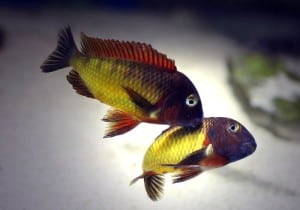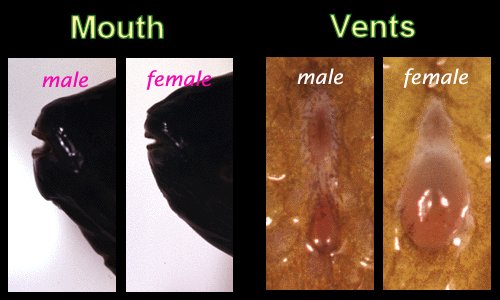
Common name: Tropheus Moorii Ilangi
Scientific name: Tropheus sp. Ilangi
Average Adult Fish Size: 15cm / 6 Inches
Place of Origin: Lake Tanganyika
Typical Tank setup: Rocky Tanganyika tank
Recommended Minimum Aquarium Capacity: 200 Litres
Compatibility: Tropheus cichlids should really be kept with other Tropheus however the following are also compatible:
- Petrochromis
- Julidochromis
- Lamprologus
- Spathodus
- Eretmodus
- Tanganicodus
- Mbuna Malawi Cichlids
Take a look at our guide to keeping Tropheus cichlids with other fish.
Temperature: 24-27 Deg C / 74-79 Deg F
Water chemistry: pH 7.6-8.6
Feeding: Spirulina-based flake food supplimented with fresh green vegetables such as romaine lettuce and spinach.
Sexing: Males tend to have a turned-up nose while females tend to have a greater slope and rounded nose. Males will also grow at a faster rate (generally) and display their adult colors sooner. Males’ coloration is also often more bold than females’ because they like to show it off when courting females. Adult males will also tend to have a deeper body, whereas females appear more slim and streamline. While these characteristics may help an experienced hobbyist, venting is the only sure way to determine gender with Tropheus.

Breeding: Males are quite territorial and are aggressive in their attempts to coax females to spawn. They never seem to tire of this either – males want to spawn every minute of the day. This fish should never be kept in 1:1 ratios. One male to three or four females is an ideal ratio, but keep in mind that the only correct way to keep this species in captivity is in a group of ten or more individuals. The most difficult challenge to breeding Tropheus is bringing the females into spawning condition.
Additional Information: Even though Tropheus species are hearty, keeping them is not without challenges. The Tropheus fish can be the most rewarding of cichlid to keep though due to the rich colouration and constant activity of the fish. The Tropheus Ilangi is often thought of as the king of the Tropheus with regards to it’s rarity and demand, this is due to the rich colouration the adults can often have. It is also one of the hardest of the Tropheus to breed.
They are caught from Lake Tanganyika in the southern part of the lake in a small bay a few kilometres from the Eastern entrance to Nkamba Bay. Since the Tropheus Ilangi was first imported in to Europe in the early 1990’s it has always been high on the want and demand list of Tropheus keepers.


Related Posts
Croaking Gourami – Trichopsis vittatus
Benthochromis Tricoti
Large-eyed Mouthbrooder – Callochromis Macrops